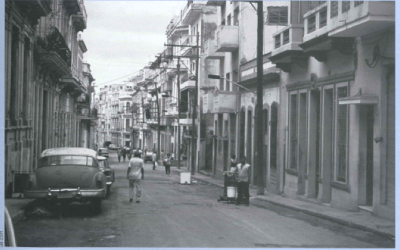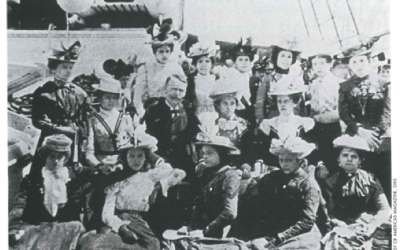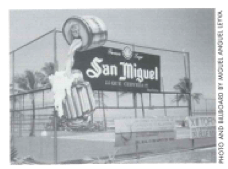The Cienfuegos Botanical Garden
Harvard’s Legacy, Cuba’s Challenge
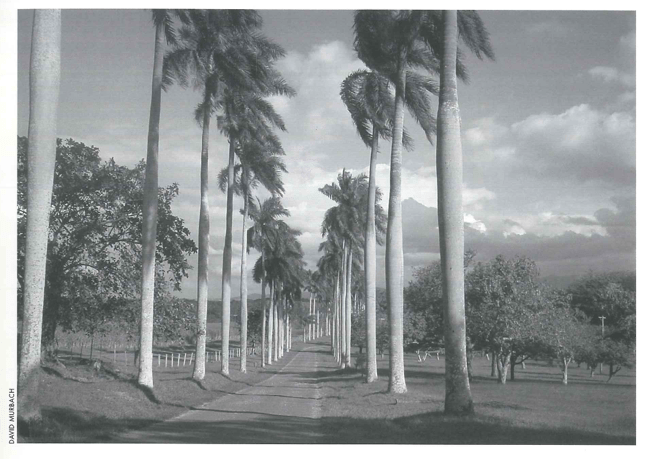
Palms at entrance of Cienfuegos Botanical Gardens
The Cienfuegos Botanical Garden, about three-quarters of an hour outside the Cuban city of Cienfuegos at the “Pepito Tey” sugar complex, welcomes visitors to a park-like setting of palms, orchids, bamboos, and myriad other tropical plants. The exotic vegetation; the shade, stream, and entry lane of royal palms; the reciprocally appreciative toasts of cane juice provoked by “official” visits-all stand in inviting contrast to the sugar mill’s neighboring clangor and sweat.
The enticements of this neotropical Garden of Eden, however, suggest questions as well as contentments. Why so splendid a facility, so far from the beaten track? How did the Garden come by its more than two thousand tropical species? What purpose does it serve? From whence the now-faded markers of a Harvard connection?
Our story finds its start in Boston and in Cienfuegos itself. Cuba was one of Spain’s first New World conquests. Cienfuegos, however, was only founded in 1819, after a lag of some 300 years. Sugar was by then the dominant cash crop and Yankee merchant firms, among them Boston’s “E. Atkins & Company,” were active in its exchange. Thus Edwin F. Atkins, the founder’s son, first visited the island in the 1860s in order to master the family trade and the connections upon which it was based. The exposure took, and Edwin gradually assumed complete control over the Cuban operation.
Atkins began his business life in a commercial world based on consignments and commissions. Sugar production, however, was already in flux. Mechanized refineries required heavy investments. Shifting tariffs, population movements and industrialization in the Northern hemisphere, and emerging product competition from both European beet sugar and Pacific sugarcane created an ever-changing structure of sources, prices, and markets.
Cuban planters also had to adjust to endemic civil unrest and the abolition of slavery. Many were unsuccessful. Atkins, despite strong misgivings, thus settled an intractable debt by taking over the “Soledad” sugar estate around 1880. The plunge once taken, he invested heavily in additional land and technological improvements. He wintered on the estate, often without his family, and forged one of the island’s most productive sugar complexes. The process was not without risk: banditry, brushes with armed bands allied to every possible faction, and repeated seasons of arson-damaged cane became almost commonplace as the island chafed under Spanish rule.
Atkins, who hoped that greater Cuban autonomy within the Spanish Empire would end the unrest, championed this outcome through his high-level connections in both Washington and Havana. He later on quickly accepted North American occupation as a portent of peace and stability. His thoughts almost as quickly turned to intensifying Soledad’s sugar production, with Harvard as one of the vehicles. In 1899, Atkins donated $2,500 to the University to compile a comprehensive bibliography on sugarcane and to fund a “traveling fellowship in economic botany,” whose recipient was expected to conduct research that would improve the island’s cane production.

the Harvard tree
The decades following Atkins’s death saw programs at the Botanical Garden meander along a course defined by several overlapping tensions. Civil unrest remained endemic, though several decades of relative calm followed the revolutionary movement of 1933. Increasingly stringent labor laws mandated higher minimum wages, limitations on non-Cuban workers, and a 1933 reduction in the work week to but forty-eight hours. Ever-increasing costs became the norm. The Garden’s vulnerability to flood, drought, and hurricane reinforced the sense of contingency.
By the mid-1930s, the Garden routinely overspent the income from the Atkins endowment, despite repeated additional gifts from Mrs. Atkins and from the Claflins, her son-in-law’s family. Programmatic fuzziness exacerbated the financial tensions between Garden and gown. Was the Garden’s destiny to become a first-rate tropical arboretum? Or was its purpose to conduct original research? In the latter case, should its focus be practical or theoretical, or should it simply respond to requests as received?
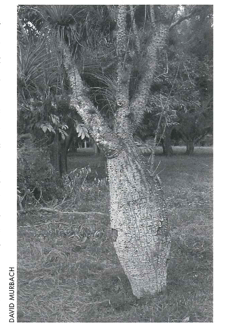
The Botanical Garden in fact engaged in a variety of pursuits. Wartime appeals from Washington led to experiments with rubber trees. Research on tropical food crops reflected Edwin Atkins’s initial wish that the Garden, as one of its goals, address the island’s general welfare. Rare botanical specimens were exchanged with facilities all over the world. Tree saplings were cultivated for reforestation efforts at Soledad and neighboring estates, and landscaping plants were dispatched to the new U.S. base at Guantanamo Bay. By the 1950s, Harvard was using the Garden for summer courses in Tropical Botany. The Garden became a local tourist destination as well, provoking worried accounts of thirsty plant lovers’ needs for potable water and more general supervision.
The Castro Revolution, and the following downward spiral in U.S.-Cuban relations, provoked an extended hiatus in the Harvard connection. Operations were gradually reduced as of 1959, and direct financial support ceased as of September, 1961. The Cuban government took over the facility, and has managed it ever since. New possibilities for collaborative teaching and research may now, after more than a generation, be on the horizon: the Harvard-Garden relationship may have life in it yet.
Winter 2000
Dan Hazen, Widener Library’s Librarian for Latin America, Spain, and Portugal, visited Cienfuegos for an international conference of historians and archivists in March 1998. This article has been condensed from a longer version, which appeared in the Fall 1998 issue of DRCLAS NEWS, which focused on the environment in Latin America.
Related Articles
The “Wordly” Classroom
Nearly two years ago, I took 17 graduate public policy students from Harvard’s Kennedy School of Government, ages 23 to 40, to Cuba as part of a short course called…
The Summer School for Cuban Teachers
A hundred years ago, 1,300 Cuban teachers traveled to Harvard to get the training they needed to cope with the new American-style educational system imposed on Cuba by the…
Socialism with Commercials
A cacophony of sounds and colors welcomed the visitor to the annual Havana Commercial Fair at ExpoCuba on the outskirts of Havana. Displays of rum, mattresses, shampoos, cab services…

